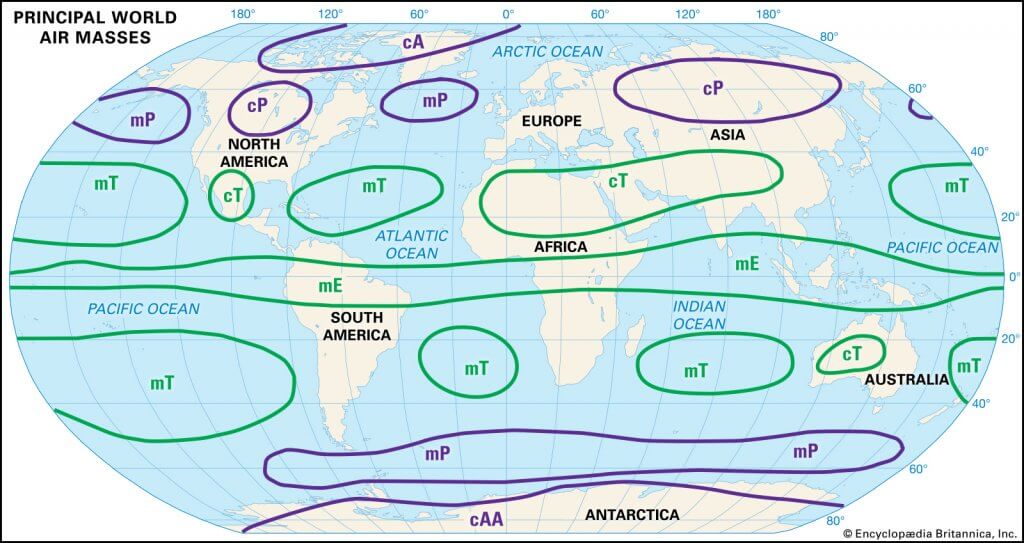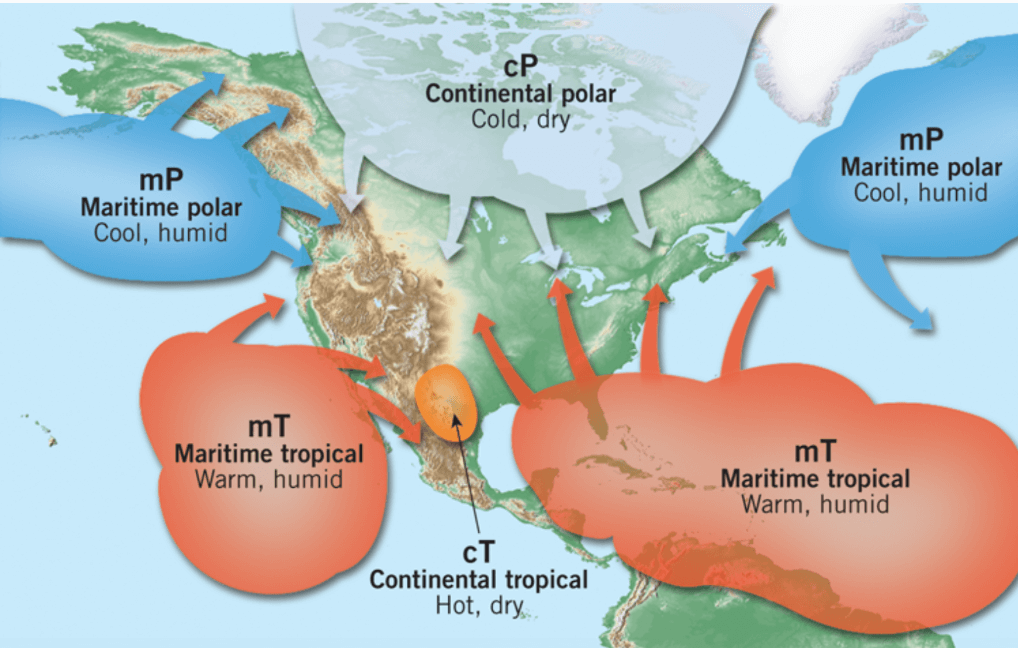In this article, You will read Air Mass & Air Masses based on Source Regions – for UPSC IAS.
Air Mass
- When the Air remains over a homogenous(uniform structure or composition) area for a sufficiently longer time, it acquires the characteristics of the area. The homogenous regions can be the vast ocean surface or vast plains and plateaus.
- The air with distinctive characteristics in terms of temperature and humidity is called an air mass. It is a large body of air having little horizontal variation in temperature and moisture.
- Air masses form an integral part of the global planetary wind system. Therefore, they are associated with one or other wind belts.
- They extend from the surface to the lower stratosphere and are across thousands of kilometers.
Source regions
- The homogenous surfaces, over which air masses form, are called the source regions.
- The main source regions are the high-pressure belts in the subtropics (giving rise to tropical air masses) and around the poles (the source for polar air masses).
- Source Region establishes heat and moisture equilibrium with the overlying air mass.
- When an air mass moves away from a source region, the upper level maintains the physical characteristics for a longer period. This is possible because air masses are stable with stagnant air which does not facilitate convection(vertical movement of air). Conduction and radiation in such stagnant air are not effective.
Conditions for the formation of Air masses
- Source region should be extensive with gentle, divergent air circulation (slightly at high pressure).
- Areas with high pressure but little pressure difference or pressure gradient are ideal source regions.
- There are no major source regions in the mid-latitudes as these regions are dominated by cyclonic and other disturbances.

Conditions for the origin of Air masses
- Homogeneous Surface
- Isotropic surface
- Lack of turbulence in the air
- Lack of convection in air
- Subsiding air with high pressure
- Atmospheric stability
- Kinetic energy of wind and friction
Size and dimension
- Extend till Tropopause
- Width is hundreds of km
- Height varies b/w 8-12 km
- Latitudinal extent varies from 3000-6000 km
Classification of Air Masses
Classification of Air Masses based on –
- Nature of Surface
- Continental
- Marine
- Source region
- Polar
- Tropical
- Temperature
- Cold
- Warm
- Atmospheric conditions
- Stable
- Unstable
- Broadly, the air masses are classified into polar and tropical air masses.
- Both the polar and the continental air masses can be either of maritime or continental types.

Air masses based on Source Regions
- There are five major source regions. These are:
- Warm tropical and subtropical oceans;
- The subtropical hot deserts;
- The relatively cold high latitude oceans;
- The very cold snow-covered continents in high latitudes;
- Permanently ice-covered continents in the Arctic and Antarctica.
- Accordingly, the following types of airmasses are recognized:
- Maritime tropical (mT);
- Continental tropical (cT);
- Maritime polar (mP);
- Continental polar (cP);
- Continental arctic (cA).
- Tropical air masses are warm and polar air masses are cold.
- The heat transfer processes that warms or cools the air take place slowly.

Cold Air Mass
- A cold air mass is one that is colder than the underlying surface and is associated with instability and atmospheric turbulence. (because of moisture and very low temperature)
Cold source regions (polar air masses)
- Arctic Ocean – cold and moist
- Siberia – cold and dry
- Northern Canada – cold and dry
- Southern Ocean – cold and moist
Warm Air Mass
- A warm air mass is one that is warmer than the underlying surface and is associated with stable weather conditions.
Warm source regions (tropical air masses)
- Sahara Desert – warm and dry
- Tropical Oceans – warm and moist
Influence of Air Masses on World Weather
- The properties of an air mass which influence the accompanying weather are vertical distribution temperature (indicating its stability and coldness or warmness) and the moisture content.
- The air masses carry atmospheric moisture from oceans to continents and cause precipitation over landmasses.
- They transport latent heat, thus removing the latitudinal heat balance.
- Most of the migratory atmospheric disturbances such as cyclones (temperate cyclones) and storms originate at the contact zone between different air masses and the weather associated with these disturbances is determined by characteristics of the air masses involved.
Continental Polar Air Masses (CP)
- Source regions of these air masses are the Arctic basin, northern North America, Eurasia, and Antarctica.
- These air masses are characterized by dry, cold, and stable conditions.
- The weather during winter is frigid, clear, and stable.
- During summer, the weather is less stable with the lesser prevalence of anticyclonic winds, warmer landmasses, and lesser snow.
Maritime Polar Air Masses (MP)
- The source region of these air masses are the oceans between 40° and 60° latitudes.
- These are actually those continental polar air masses that have moved over the warmer oceans, got heated up, and have collected moisture.
- The conditions over the source regions are cool, moist, and unstable. These are the regions which cannot lie stagnant for long.
- The weather during winters is characterized by high humidity, overcast skies, and occasional fog and precipitation.
- During summer, the weather is clear, fair, and stable.

Continental Tropical Air Masses (CT)
- The source-regions of the air masses include tropical and sub-tropical deserts of Sahara in Africa, and of West Asia and Australia.
- These air masses are dry, hot and stable and do not extend beyond the source.
- They are dry throughout the year.
Maritime Tropical Air Masses (MT)
- The source regions of these air masses include the oceans in tropics and sub-tropics such as Mexican Gulf, the Pacific, and the Atlantic oceans.
- These air masses are warm, humid, and unstable.
- The weather during winter has mild temperatures, overcast skies with fog.
- During summer, the weather is characterized by high temperatures, high humidity, cumulous clouds, and convectional rainfall.

Thank you very much ,you are doing a great job, very helpful
Most Welcome
You are great sir, please make a list of MCQ also for upsc.